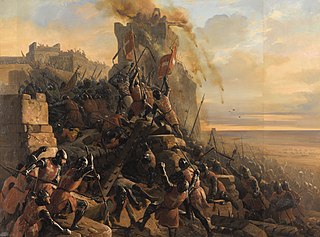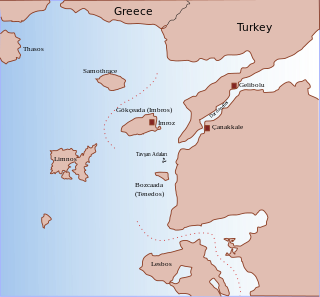
Anatolian beyliks were small principalities in Anatolia governed by beys, the first of which were founded at the end of the 11th century. A second and more extensive period of establishment took place as a result of the decline of the Seljuq Sultanate of Rûm in the latter half of the 13th century.

The Karasids or Karasid dynasty, also known as the Principality of Karasi and Beylik of Karasi, was an Anatolian beylik in the area of classical Mysia from ca. 1297–1345. It was centered in Balıkesir and Bergama, and was one of the frontier principalities established by Oghuz Turks after the decline of the Seljuk Sultanate of Rum.

The Aydinids or Aydinid dynasty, also known as the Principality of Aydin and Beylik of Aydin, was one of the Anatolian beyliks and famous for its seaborne raiding.

Menteshe was the first of the Anatolian beyliks, the frontier principalities established by the Oghuz Turks after the decline of the Seljuk Sultanate of Rum. Founded in 1260/1290, it was named for its founder, Menteshe Bey. Its capital city was Milas (Mylasa) in southwestern Anatolia.

The Sarukhanids or Sarukhanid dynasty, also known as the Principality of Saruhan and Beylik of Saruhan, was one of the Anatolian beyliks, centered in Manisa.

Umur Ghazi, Ghazi Umur, or Umur The Lion, also known as Umur Pasha was the second Turkoman bey of Aydin, on the Aegean coast of Anatolia, from 1334 to 1348. He was famous for his naval expeditions. During his reign, he fought off many Crusades against him called out by the Pope.

The Palaiologan army refers to the military forces of the Byzantine Empire under the rule of the Palaiologos dynasty, from the late 13th century to its final collapse in the mid-15th century. The army was a direct continuation of the forces of the Empire of Nicaea, which itself was a fractured component of the formidable Komnenian army of the 12th century. Under the first Palaiologan emperor, Michael VIII, the army's role took an increasingly offensive role whilst the naval forces of the empire, weakened since the days of Andronikos I Komnenos, were boosted to include thousands of skilled sailors and some 80 ships. Due to the lack of land to support the army, the empire required the use of large numbers of mercenaries.

The Smyrniote crusades (1343–1351) were two Crusades sent by Pope Clement VI against the Beylik of Aydin under Umur Bey which had as their principal target the coastal city of Smyrna in Asia Minor. The crusade was mostly successful in restricting piracy and leading to Umur's death and Smyrna remained in Latin hands until 1402.
Juneyd or Junayd Bey was the last ruler (bey) of the Aydınid principality in what is now central western Turkey. His exact relationship with the Aydınid dynasty is unclear. His father was a long-time and popular governor of Smyrna under the Ottoman sultan Bayezid I. This allowed Junayd to consistently rely on the loyalty of the area's populace.
Neokastra was a Byzantine province (theme) of the 12th–13th centuries in north-western Asia Minor.
The Battle of Chios was a naval battle fought off the shore of the eastern Aegean island of Chios between a Latin Christian—mainly Hospitaller—fleet and a Turkish fleet from the Aydinid emirate. The Christian fleet was victorious, but for the Aydinids, who had been engaging in piracy since the collapse of Byzantine power, it was only a temporary setback in their rise to prominence.

Pietro Zeno was the Venetian captain and bailiff of Negroponte (1331–33) and one of the leaders of the Smyrniote crusade (1343–45).

The Hospitaller conquest of Rhodes took place in 1306–1310. The Knights Hospitaller, led by Grand Master Foulques de Villaret, landed on the island in summer 1306 and quickly conquered most of it except for the city of Rhodes, which remained in Byzantine hands. Emperor Andronikos II Palaiologos sent reinforcements, which allowed the city to repel the initial Hospitaller attacks, and persevere until it was captured on 15 August 1310. The Hospitallers transferred their base to the island, which became the centre of their activities until it was conquered by the Ottoman Empire in 1522.
The Battle of Pallene occurred in 1344 between the fleets of a Latin Christian league and Turkish raiders, at the Pallene Peninsula in northern Greece.
Battle of Adramyttium or Adramyttion can refer to:

The Battle of Gallipoli occurred on 29 May 1416 between the fleets of the Republic of Venice and the Ottoman Empire off the port city of Gallipoli, the main Ottoman naval base. The battle was the main episode of a brief conflict between the two powers, resulting from Ottoman attacks against possessions and shipping of the Venetians and their allies in the Aegean Sea in 1414–1415. The Venetian fleet, under Pietro Loredan, was charged with transporting a Venetian embassy to the Ottoman sultan, but was authorized to attack if the Ottomans refused to negotiate. The subsequent events are known chiefly from a detailed letter written by Loredan after the battle.

The War of Curzola was fought between the Republic of Venice and the Republic of Genoa due to increasing hostile relations between the two Italian republics. Spurred largely by a need for action following the commercially devastating Fall of Acre, Genoa and Venice were both looking for ways to increase their dominance in the Eastern Mediterranean and Black Sea. Following the expiration of a truce between the republics, Genoese ships continually harassed Venetian merchants in the Aegean Sea.
The Battle of Imbros occurred in spring 1347 between the fleets of a Christian naval league formed as part of the Smyrniote crusades, and of a Turkish raiding fleet, possibly from the beyliks of Aydin and Sarukhan. The Turks abandoned their ships and landed on the island of Imbros, where most were captured.
The Holy League was a military alliance of the chief Christian states of the Aegean Sea and the Eastern Mediterranean against the mounting threat of naval raids by the Turkish beyliks of Anatolia. The alliance was spearheaded by the main regional naval power, the Republic of Venice, and included the Knights Hospitaller, the Kingdom of Cyprus, and the Byzantine Empire, while other states also promised support.
In 1320, the Turks of Menteshe launched an unsuccessful attempt to conquer the island of Rhodes from the Knights Hospitaller.










